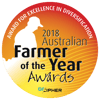Princess Royal Station
Feedlot

Our Facility
According to the Environmental Protection Authority (EPA), Princess Royal Station Feedlot is a Class 1 feedlot and is accredited under the National Feedlot Accreditation Scheme (NFAS). The facility features advanced systems and practices which include a tempering mill, for higher quality feed, better animal digestion, as well as air-operated crush and drafting facilities. The design of the complex creates an efficient, low-stress environment for cattle during the induction and exit processes.
Under the LPA QA program (Livestock Production Assurance on farm Quality Assurance), the feedlot runs under the EUCAS (European Union Cattle Accreditation Scheme). This is a national animal production scheme which allows Australia to meet the European Union (EU) beef market requirements by segregating cattle that have never been treated with hormonal growth promotants. Princess Royal Feedlot is EU accredited.
In addition, the Princess Royal Feedlot is accredited to supply European Union Grain Fed High-Quality Beef (EU GF-HQB) Eligible Livestock. This certifies that facility has the ability to produce beef that goes beyond the Aus-Meat Minimum Standards for Grain Fed Beef and the general requirements of NFAS accreditation and the EUCAS.
Princess Royal Feedlot is MSA (Meat Standards Australia) accredited. MSA is an endorsement of quality, it indicates that our products meet quality standards for tenderness, juiciness, and flavour.
National and State Guidelines, Regulations and Codes that Princess Royal Feedlot adhere to:
• National Guidelines for Beef Cattle Feedlots in Australia
• National Beef Cattle Feedlot Environmental Code of Practice
• Model Code of Practice for the Welfare of Animals
• Ausvetplan
Beef produced in an Australian feedlot environment is more efficient, less land is required, less stress placed on the environment and less greenhouse gas are emissions produced (ALFA, 2006).

Our Practices
There is great deal here at Princess Royal Feedlot that we strive to achieve. Below is a small portion of the procedures and methods already in place to help meet our goals productively:
Bio Security - Measures and protocols have been implemented to prevent disease from entering or leaving the facility via contaminated vehicles, clothing, footwear, equipment, and animals.
Training - We believe that skilled and properly trained staff benefit the business overall. This provides our team members with a greater confidence in the part they play with our business. Our team members constantly participate in relevant training courses and information seminars to better their knowledge, practices, techniques and processes.
Waste Product Management - Our facility features large storage lagoons that have been designed to withstand a 1 in 50 year flood event. All of the run off from the facility goes into these specially designed lagoons. The lagoons give us the ability to use the liquid waste for irrigation and as a natural fertilizer purposes for nearby farming country. The solid waste removed from the pens is composted, heated and all bugs are removed. It is then safe to use in other areas of our business as a natural fertilizer.
Weather Management - All pens are cleaned regularly to prevent manure build up. This assists with the drainage system and ensures that solid material does not change the direction of the run-off.
Animal Nutrition - Is one of the most important aspects of the feedlot. Our aim is for the animals' to reach a specific optimal weight during a set period of time. Our qualified Animal Nutritionist advises us regularly of methods, quality feed and creates for us a feed management program which dictates the quantity of feed for a desired performance response.
Research & Development - We are constantly seeking to discover processes and procedures that will improve our facility effectiveness and efficiency. One which will cause the least possible harm to the environment and to our animals.
